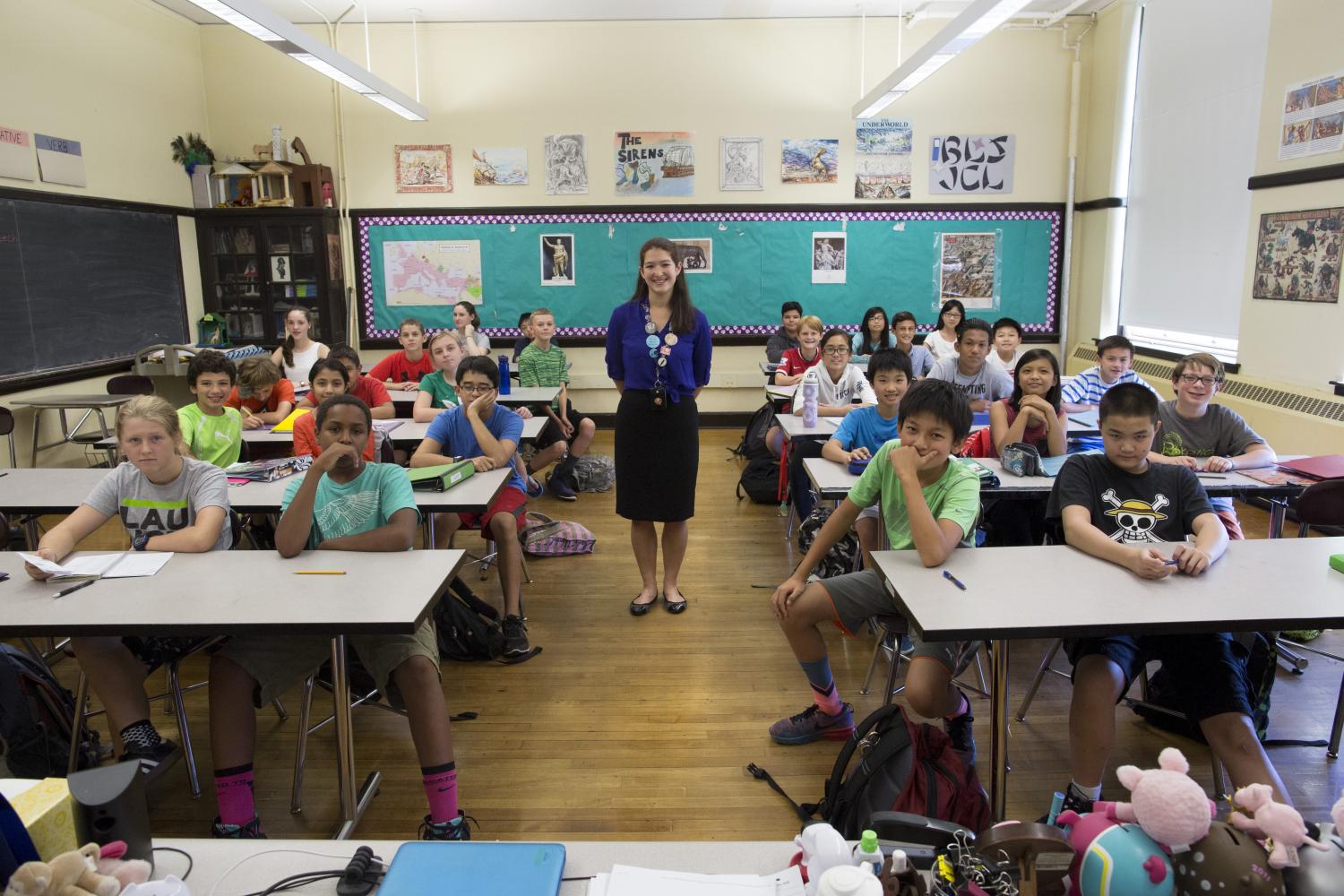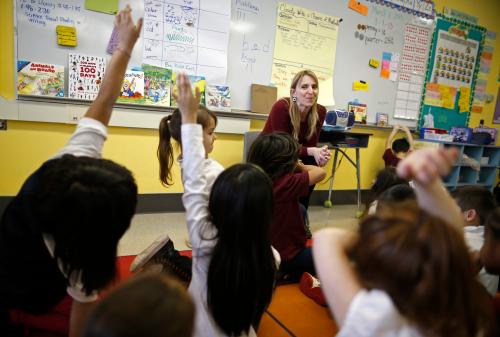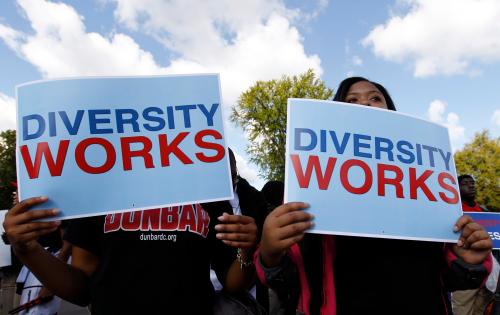This post is part of “Teacher diversity in America,” a series from the Brown Center on Education Policy that examines minority underrepresentation among public educators in the U.S.
Last month, we kicked off a series focused on diversity in the public teacher workforce with an article looking at patterns and trends in the diversity gap across locales, school sectors, and teacher generations. This analysis showed, among other things, that the diversity gap is not monolithic, but varies across different places. We extend this analysis in today’s post by mapping the depth and breadth of gaps across the U.S.
Conversations to date about teacher diversity gaps have largely lacked geographic detail. Prior research about teacher diversity, including ours, has almost exclusively used data from national sources to present a picture of diversity gaps through a macro lens. (There are a few notable exceptions using more localized data sources focusing on particular states or metro areas, including a new data visualization from the Urban Institute.)
The problem with the macro lens, of course, is that it masks underlying variation that may be occurring across the nation with respect to diversity gaps. Teaching is a very localized occupation, and these gaps are expected to vary across different geographies depending on both student and teacher demographics.
To provide a more comprehensive picture of the variation in diversity gaps across the country, we produced a series of maps using data from the American Community Survey. This is a nationally representative survey in which 3.5 million households are sampled every year. The five-year estimates, which we use, aggregate survey responses between 2011-2015 and report on all households down to the level of public use microdata areas (PUMAs)—Census-designated areas corresponding to regions of states containing at least 100,000 people.
We identify all households in which an adult reports being a full-time teacher working in public schools and the number of all school-age children enrolled in public schools, and the racial/ethnic background of both groups.[1] Approximately 120,000 teachers appear in this sample, spread across 2,351 PUMAs, providing a fairly localized snapshot of the teacher workforce across the U.S.
From these data, we estimate diversity gaps for each PUMA, which represents the percentage point difference between the share of minorities among the student population in public schools and share of minorities among the full-time public teacher workforce. For example, a region with a student body comprised of 30 percent minority students with a 5 percent minority teacher workforce results in a diversity gap of 25 percentage points (found by subtracting the 5 percent from 30 percent). This metric, though a useful and widely utilized measure in discussions of teacher diversity, has its shortcomings. In our next post in the series, we will discuss different ways to quantify variations between student and teacher representation and how it might affect our priorities about where minority teachers are most needed.
Figure 1 below shows what black diversity gaps (those based on black student and teacher percentages only) look like down to the PUMA level. Different regions are shaded according to the severity of the local black diversity gap, where darker shades of red represent greater levels of minority underrepresentation among teachers. We categorize the gaps into four groups: “no gap” means the difference in student and teacher representation is less than 5 percentage points; “small gap” represents gaps of 5-10 percentage points; “moderate gap” represents gaps of 10-20 percentage points; and “large gap” represents gaps of 20 percentage points or more.

It is noteworthy to see that black diversity gaps (and, below, gaps for Hispanics and other races follow suit) vary widely across the country and generally parallel known demographic patterns. As can be clearly seen, black diversity gaps are largest across the South, Mid-Atlantic, and in major urban centers in the broader Rust Belt region.
Much of the country registers no black diversity gap. This is typically not because these regions hire black teachers in parity with their black students, but more often because the black student population constitutes less than 5 percent of the student population; therefore the maximum gap value for that area (i.e., not hiring a single black teacher) falls below the threshold to be considered a small gap.
Figure 2 maps out the diversity gaps between Hispanic students and teachers.

These Hispanic diversity gaps are both deeper and broader than black diversity gaps. The two figures use the same color scale boundaries, making it easy to see that Hispanic diversity gaps are moderate and large over much larger swaths of the country—including virtually all of the Western U.S.—than black diversity gaps.
Some regions stand out for having smaller gaps than we may otherwise expect based on demographics. For example, south Texas along the Rio Grande Valley is overwhelmingly Hispanic, yet the diversity gaps there are considered moderate or even lower. Thus, an area’s minority student share is not entirely predictive of large teacher diversity gaps there. (This could also be a reflection of a homogeneous minority population among both students and teachers, which we discuss in the next post.)
The figure below maps diversity gaps for all other racial groups. Here, regions like Alaska, the San Francisco Bay area, and the upper plains states to the Pacific Northwest (known for sizable Asian, Native American, or Pacific Islander populations) all register gaps in the teacher workforce.

Finally, instead of measuring diversity gaps separately by race, we measure diversity gaps based on any minority status (where black, Hispanic, Asian, Native American, Pacific Islander or other underrepresented races are treated interchangeably). This gives us an interesting—well, sobering—snapshot of the United States as shown in Figure 4.

This map shows there are only a few areas peppered across the country where the minority student populations are small enough, or the teacher populations are diverse enough, to show no diversity gap. Everywhere else, districts face some level of diversity gap, and in most cases, that diversity gap is moderate or larger. Indeed, 61 percent of PUMAs across the U.S. fall into the “large gap” categorization with diversity gaps in excess of 20 percentage points.
The evidence presented here shows diversity gaps are large and generally widespread across the US. Any policymaker or practitioner that may have heard news coverage about teacher diversity gaps and dismissed it as a big city problem would benefit from taking a close look at the map in Figure 4. Chances are, these gaps hit closer to home than most realize.
Footnote
- We restrict our sample to full time public school teachers, between 25 and 65 years old, with at least a bachelor’s degree. Full-time teachers are individuals who worked at least 40 hours per week for at least 40 weeks and whose wage income is between $20,000 and $150,000. Students are children, between 4 and 18 years old, enrolled in public schools.
The Brookings Institution is committed to quality, independence, and impact.
We are supported by a diverse array of funders. In line with our values and policies, each Brookings publication represents the sole views of its author(s).










